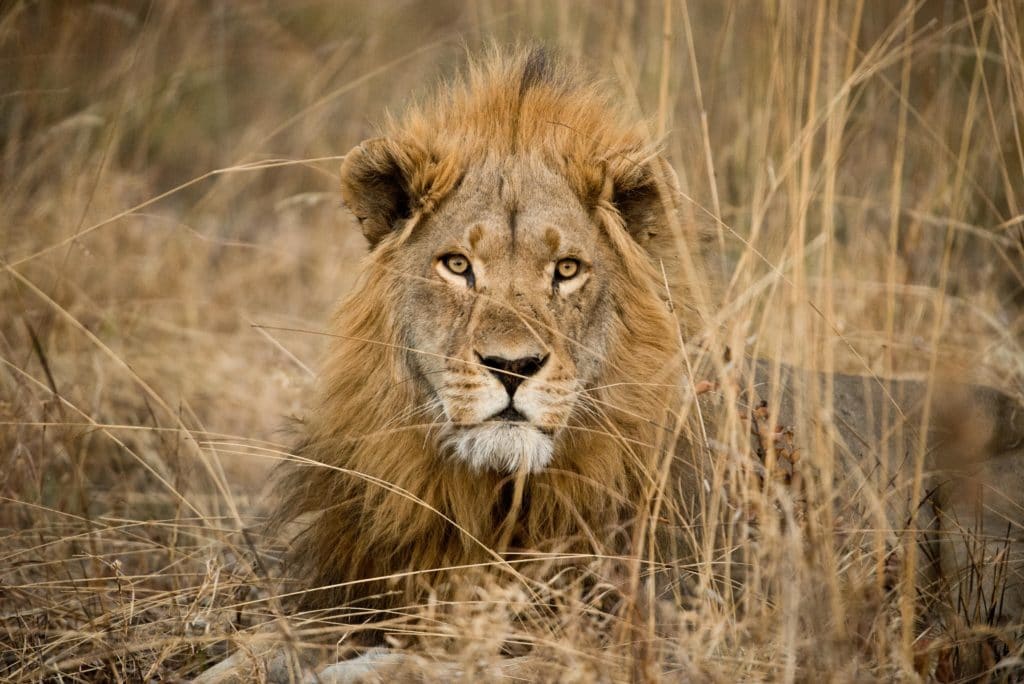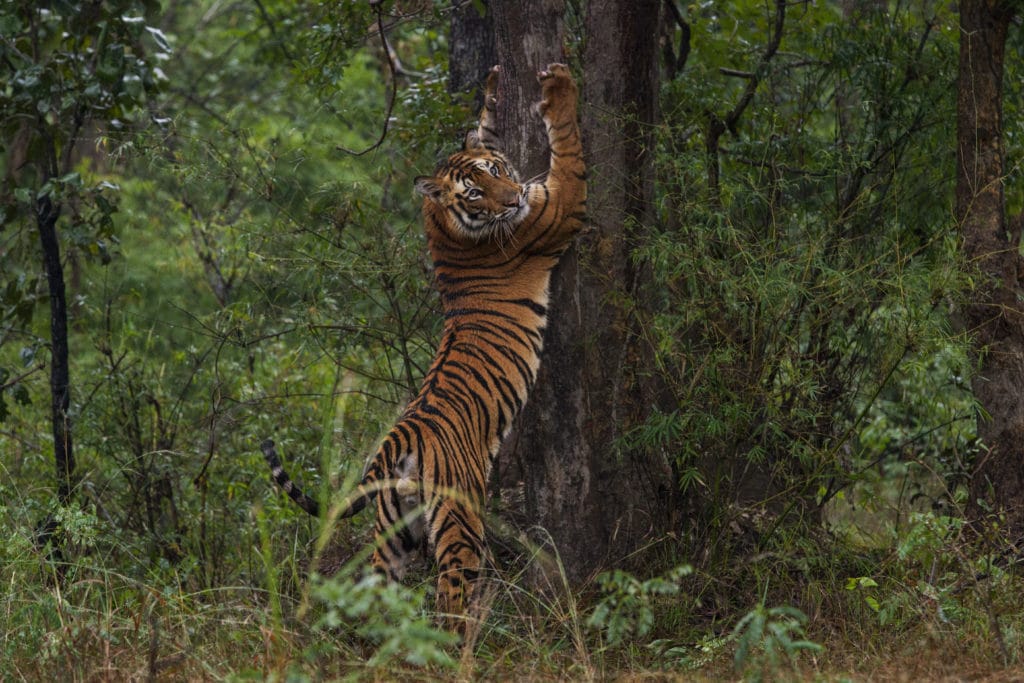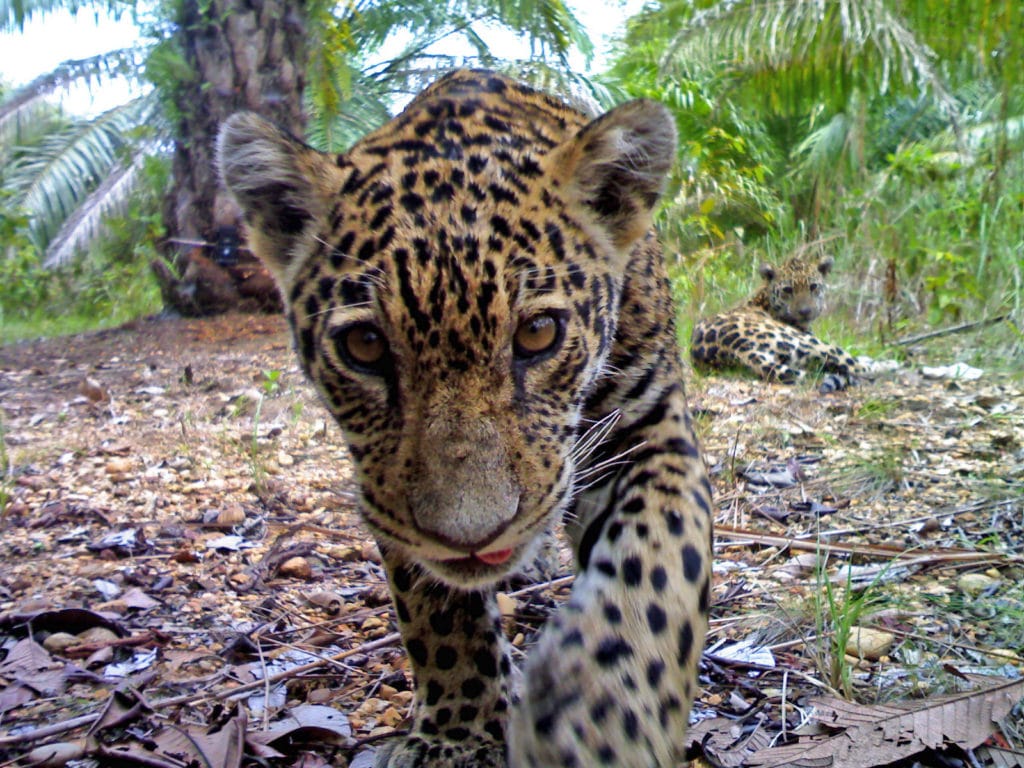Panthera - Wild Cat Conservation Interview
How worried should we be about the world’s wild cats? Well, it turns out we’re not the only ones struggling with environmental changes and dwindling resources. Panthera is the only organisation in the world that focuses exclusively on wild cat conservation and in today’s episode, we learn more about some of their work across the globe.
Listen here or find us on your favorite podcast app.
September 30, 2020
Panthera: Getting Big Cats Out of Trouble



Talking Wildcat Conservation with Panthera
How worried should we be about the world’s wild cats? Wild cats being lions, tigers, jaguars and, as it turns out, quite a few more species.
We spoke with Jamie Zaccaria from Panthera, an organisation working in wild cat conservation, to find out.
Panthera is devoted to protecting the 40 species of wild cats found around the world. Jamie told us “As we continue to deal with habitat loss and climate change around the globe, wildlife and especially wild cats are in trouble.” Habitat loss may be the main threat but it isn’t the only reason wild cats are in trouble. These creatures are also at risk of being poached for commercial use and becoming victims of retaliation from communities such as farmers trying to protect their livestock.
Despite all these threats, Jamie exhibits a great deal of energy and optimism when talking about the work Panthera does to increase numbers of these wild cat species. The organisation has a wide spread of activities all over the world, with hubs in Colombia, Costa Rica, South Africa and various regions of Asia. They work with local communities, scientists and specialists to tackle specific on site conservation problems. They also work in global advocacy, trying to create stronger international laws to protect wild cats and raise awareness on the issues they’re facing. They encourage people to be a “voice for the voiceless”, as their late co-founder Alan Rabinowitz aspired.
The organisation seems like it’s formed and supported by the kind of close-knit community any cause could benefit from. “At Panthera we tried to break down the work that we do so that our audience, our members and supporters, who are very loyal, know what we're doing on the ground.” From working with communities in northern India to reduce the killing of snow leopards to training ranger teams in Malaysian forests to catch poachers, they like to keep their supporters updated.
To explore Panthera’s individual projects and support their work you can head on over directly to their website (bonus: it’s full of amazing photos and videos of cats);
Or listen to the 16 minute interview here.
Either way, you're in for a treat.
Great.com was founded in 2017 with the goal of generating donations to stop climate change. The organization operates within the typically uncharitable online casino industry, where it tries to create something good out of something sometimes harmful. Great.com generates profits by competing with traditional casino companies in Google search rankings for online gaming signups coming from search terms such as "casino slot games" and "best online casino NJ". All profits are then donated towards causes fighting against climate change. So far we have generated donations of over $1.3 million.
[00:00:00] Welcome today, great.com talks with Panthera.org. And that’s a really cool word in general, Panthera. It’s one of my favorite words. And I learned a year ago that it means cat animal. So for you, that is new here. The purpose of this podcast is to introduce you, our listeners, to exciting charities, organizations that want to make the world a better place and explain what they do and the challenges they might face within their causes in a way that is easy to understand. And today’s organization, Panthera.org, is interesting because they’re specialized. They’re the only organization in the world that is devoted exclusively to the conservation of who. I see a cat in the background who looks just like you. Okay. OK. So they’re devoted to the conservation of the world’s 40 wildcat species and their ecosystems. And I’m here today with Jamie Zaccaria. How are you today?
[00:01:15] Hi, how are you? I’m doing good.
[00:01:17] All right. That’s a you’re Cat looks just like you.
[00:01:20] Yeah, I guess that’s true.
[00:01:25] My dog looks exactly like me. So it happens. Now, how would you explain your organization, the costs you’re in and the challenges you’re facing? To someone that is not familiar with what you do.
[00:01:38] Sure. So I worked for Panthera. And as you said, Panthera is the only organization that is devoted exclusively protecting 40 species of wildcat around the globe. Most people are familiar with the big cat species. There’s seven of them lions, tigers, etc. But there are actually 40 wildcat species altogether. The ones that aren’t considered big cats are called small cats. 33 of those. And what we do is we do science and conservation for all 40 of those species in sites across the globe. And we focused just on those efforts.
[00:02:15] Like how special I studies. Yes. Yes. No. I’m not too aware of your whole costs.
[00:02:25] So for someone that is not aware, how worried should we be about these big cats? Because we all want them around. Obviously, they’re so beautiful, right?
[00:02:37] Yeah, I think it’s a risk.
[00:02:39] I mean, we’ve obviously had some successes in conservation, and those are great. But, you know, as we continue to deal with habitat loss and climate change around the globe, wildlife and especially wild cats are in trouble for cats, especially because these are large predators. They need large tracts of land with prey. And these are resources that are slowly dwindling. And on top of that, we’re seeing an increase in poaching of wild cats, tigers, jaguars, lions. A lot of it is related to the traditional Chinese medicine trade. But there are, of course, other reasons for poaching as well. But, you know, because poaching is increasing and habitat is decreasing, it’s kind of a struggle to preserve the habitat and the safe areas for these cats to live in.
[00:03:32] I feel for those cats. It’s like you get squeezed from two directions. So what can someone do about it? This seemed like a huge problem, quite overwhelming.
[00:03:43] Yes, it’s definitely can seem overwhelming, which is why I am there are we tried to break down the work that we do so that our audience, our members and supporters who are very loyal know what we’re doing on the ground when we have a lot of projects that are site specific and then are seeing really good results. And we like to communicate with that with you so that, you know, when you donate to Panthera, your money is going to help. For example, this community in northern India that we’re working with to reduce the killing of snow leopards or this team that we’re training in the forests of, you know, Malaysia to catch poachers before they can kill tigers and other wildlife. So obviously, you know, supporting us in our efforts is a great way to support cats. But beyond that, also just being what we call a wildcat advocate, being a voice for the animals that can’t speak up for themselves, reminding people that all of our actions have consequences, that if you participate in, you know, buying cat parts on the black market, it’s detrimental to their trade. Just kind of being aware of what’s going on, being educated and spreading the word and speaking up for them and all the habitats that they live in.
[00:04:59] So if something very good were to happen with your organization in the next coming year, what would you like for that to be or the course and general protocols?
[00:05:09] Oh, I mean, obviously, our goal is to see an increase in wildcat species, their populations, especially in the areas where they’re being threatened the most. We, for example, we have a program called Tigers Forever, which has been very successful in sites across Nepal and India in helping to increase tiger numbers and to provide protections for them. Unfortunately, we are working in other sites in South and Southeast Asia where Tiger numbers are dwindling fast because of poaching habitat loss. These sites, we’re hoping to take our successful tigers forever. Program initiatives and apply that there and to protect these populations basically before they have a chance to go extinct. So really, we’re racing against time and we’re racing against other variables to protect certain populations around the world and securing safety for those populations, securing critical and our habitat for them, and creating stronger laws internationally against the trade in cat parts. It would be really beneficial to protecting these species.
[00:06:20] Yeah, for for sure. And this must be such a multifaceted problem. For example, the people that live in close proximity to these big animals like tigers, geomedicine, snow leopard, some in there. How do the population feel towards having these big predators close to them, or are they only in nature protective areas these days?
[00:06:44] Yeah. So, no, actually, unfortunately, they’re not. And conflict with humans is a major threat to most cat species. And whether that’s direct poaching, but also what we don’t always think about is what we call retaliatory action. So in South America, Africa, Asia, people who have. Livestock. So, for example, somewhere in southern Africa, people have livestock and let’s say a lion kills one of their cows. They might kill the lion in retaliation because they can’t afford to lose their cows. That’s their livelihood. That’s how they feed their family. So this conflict back and forth is one of the major threats in some of these areas. And that’s something that we hope to address by working with communities and working on establishing techniques that protect the livestock, for example, putting in electric fences or specially designed corrals that the lions and leopards can get into. That way, it protects the livelihood of these communities, which makes them not want to necessarily kill the cats, but also instills in them a value for the cats that they weren’t, you know, didn’t necessarily have the ability to have because they were too busy worrying about their livelihood before. Mm hmm.
[00:07:59] It seems like such a such simple math is probably more much more complicated than it is. But do you see these changes as things that would be quite simple to implement as long as there was founding? Or are there more bigger complications to solving it?
[00:08:17] Yeah, I mean, it’s. Both obviously, some of these threats that we’re seeing against Wildcats are on a huge global level, loss of habitat poaching, disrupting the black market trade and cat parties. You know, a big deal when we do work on those issues, but also we focus on sites to implement these solutions that might seem a little bit simpler, a little bit more direct action to consequence. And we are seeing direct consequences. We are seeing a reduction in the amount of animals killed in sites where we have increased anti poaching efforts. So, yeah, well, the issues are large. We are directing our forces at them from multiple angles and working at sites where we can see a real difference and we are seeing a real difference.
[00:09:05] This conversation is so fascinating for me as someone that doesn’t update myself in the situation for wild animals on a regular basis. And I’m curious, let’s look back 30 years, 50 years. How has the. How is the situation for cats now compared to historically? Is it an upward trend? Is it a downward trend? How does it look in the world?
[00:09:31] Yeah. So I think it’s hard. It’s hard to say because studying wildcats is very difficult.
[00:09:39] You think about lions. They might be easier to track. But a lot of these jaguars, tigers. It’s very difficult to find them. And it’s only been in the last 50 years, the last 30 years, even even earlier, that we’ve been able to really get baseline estimates on how many cats are even out there using technology like collaring. But more importantly, camera trapping. We do know that most, if not all, of the populations are decreasing. And it’s also directly correlated to the decrease in habitat for a lot of these species and the increase in poaching. So overall, you know, wildcats are on the decline, I think, which is safe to say, for a lot of wildlife as human populations grow, as we use up natural resources, at an alarming rate. That being said, there are specific pockets where our conservation efforts are working and we are increasing their numbers and their safety. But overall, it’s still a battle. It’s still a battle that desperately needs to be fought.
[00:10:39] Oh, it is for sure. So I never thought of how difficult it actually must be to track a wildcat.
[00:10:52] Sometimes has to assume that there is data available for everything, but that must be super hard. Now, could you please paint the picture? Describe a project that you have done so far that you are particularly proud of? Maybe so. We as listeners can understand why the project you run might look like.
[00:11:10] Sure. I mentioned a little bit before the Tigers Forever program. That’s one of our programs that’s been groundbreaking in protecting Tiger numbers. So, you know, some years ago, our scientists and leaders and from other NGOs got together and thought, tigers are not doing well. What can we do? What do we do to protect them? So they came up with a plan of action that includes intensive protection, innovative community programs combining science, conservation and community.
[00:11:40] And we applied this plan at specific sites across places in India and Nepal, and we’re seeing major rebounds in their numbers. For example, in Manaus, National Park, India, where in 2011 there were only eight tigers recorded. We saw 39 in 2008. Another park pass, a national park in Nepal. In 2013, we recorded seven. Well, in 2000, 18 recorded 18. And in Banky National Park, Nepal, we went from four in 2013 to twenty one in 2018. So we’re seeing these numbers work. And it’s really exciting to know that, you know, the populations in India and Nepal were helping to increase those. And that’s why this program Tigers Forever. We’re hoping to implement it across other sites in South and Southeast Asia. So we can protect those populations as well.
[00:12:29] Those are huge increases. How does it feel for you working in an organization, loving cats so much? Having your own cat? How do you feel about seeing those numbers go up like that?
[00:12:41] It’s it’s rewarding. It’s what makes it worth it. I mean, anyone working in conservation can tell you that it’s mostly bad news. That’s just the nature of what you’re doing. And. But when you get results like that, it really hammers home the importance of combining science and policy and conservation and community outreach and makes it all really worth it. And it inspires us, like, OK, we did it here. Let’s go do it somewhere else now and save some more cats. It’s it really is inspiring. And we wouldn’t be able to do it without, you know, our large base of supporters there. They’re the people that keep us going. And so for them, we say thank you.
[00:13:18] Thank you, supporters. Is it’s a big organization, a dog or your small team?
[00:13:25] We have between 100 and 200 employees around the given time.
[00:13:29] Our headquarters is in New York. But that’s only in maybe 20 of us. We have sites all over the world. We have hubs in Columbia, Costa Rica, South Africa, all over Asia, all of it pretty much everywhere. We’re extending our reach because, you know, we have to be on the ground and working with people from these areas, with the best scientists, the best rangers, the best community members to pull all the resources.
[00:13:59] It must be interesting working in such a specialized to this organization where I guess also everyone has a very intense they feel a very strong connection to that animal. I just assume from talking with you a little bit that you feel a huge connection to cats in general. So I understand how rewarding it must be to work to preserve especially
these big, beautiful ones. Now, someone listening to this might like cats as much as you do and somehow you want to get involved. I want to help these wild cats get a brighter future. What are some things our listeners can do if they want to help you out in your calls?
[00:14:41] Yeah. So our late co-founder, Alan Rabinowitz, he founded Panthera on the idea of us being a voice for the voiceless. Cats can’t talk. So we have to be their voice. We have to say what they mean. And that’s what pain there is. So the first thing that you can do is follow us on our social media accounts, Facebook, Instagram, Twitter, YouTube, LinkedIn. Keep up to date with what we’re doing with our work around the world. And we provide amazing photos and videos of cats. So it’s totally worth it. And, you know, spread that to other people, remind people that these animals are out there and that they’re struggling in these they’re being threatened by increased poaching. They’re being threatened by habitat loss. Remind people that this is out here and, of course, support us, you know, in our endeavors and our campaigns and what we do, because, you know, our money that we get, our donations, our funding goes directly to our boots on the ground work making these changes.
[00:15:37] And to support you, someone can go to Panthera.org and make a donation. And hey, follow them on all social media platforms. Jamie, it was lovely speaking with you today. Thank you so much for being on our podcast. Thank you for having me. Thank you. And you listening. If you want to hear more. Conversation with interesting organizations. And if you want to support our cause somewhat BIDU, please go into your podcast app and press subscribe. That will greatly increase our chances to get into different top lists. Wouldn’t the charity field and we see you for the next episode. By.
END OF TRANSCRIPT



